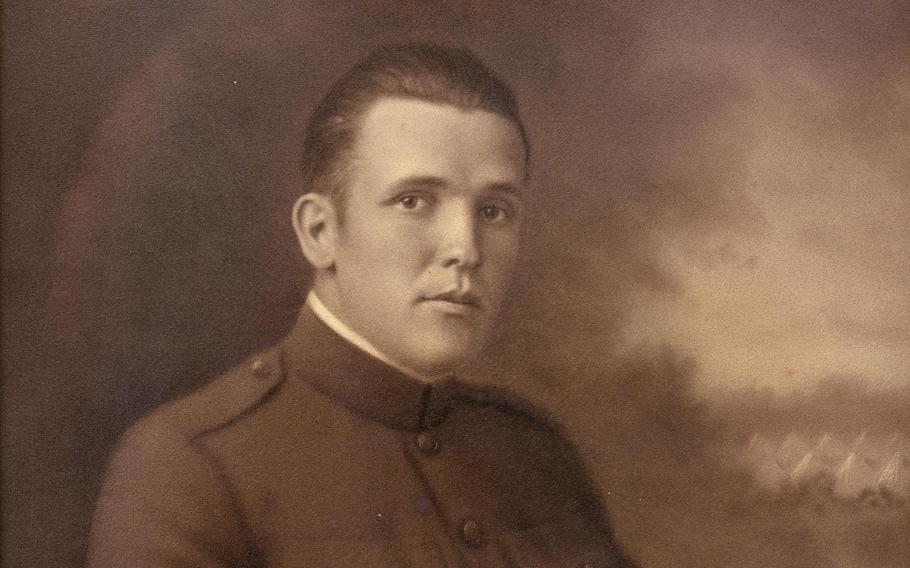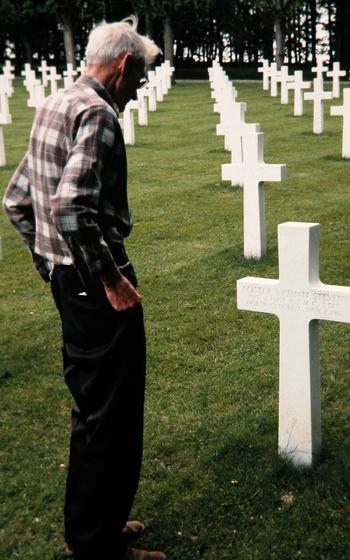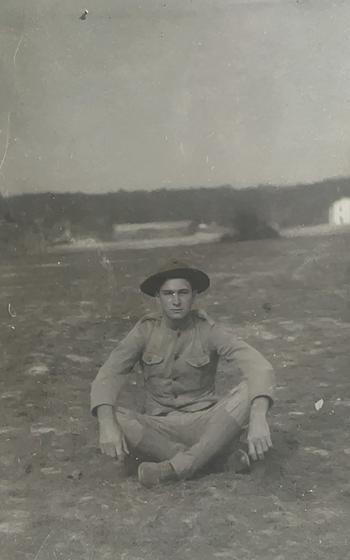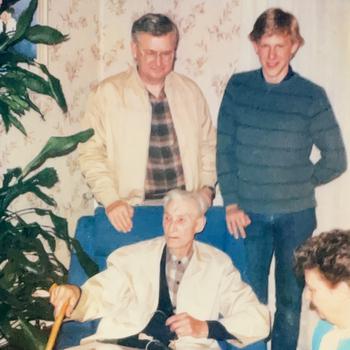
This portrait of Pvt. Foster Stevens belongs to Post reporter Joby Warrick, Stevens’s grandnephew. Stevens was killed in France during the waning days of World War I. (Warrick family photo)
They had fought together at Belleau Wood, clawing their way through enemy-infested thickets in a battle that became legendary in the Marine Corps. They had clung to the sides of the same shell hole under a fierce artillery barrage at Soissons and charged uphill against machine-gun fire on the chalky slopes of Blanc Mont Ridge.
Through five months of combat, they had been the survivors: the 83rd Company’s “old men,” though still in their 20s. Along the way, Marine Pvts. Jim Scarbrough and Foster Stevens had gone from being squad mates and comrades to best friends.
“We’ll just soldier through this, me and you,” Stevens had said in his mild North Carolina drawl as he put an arm around Scarbrough after a fierce nighttime skirmish with German defenders in June 1918. “I’ll be right here.”
Then came Nov. 2 and the start of the Great War’s last major assault. The day would begin before sunrise for the battle-weary Marines. For Scarbrough, it would end with a grief-filled encounter in the gloom of the battlefield after dark, and a searing memory that would be borne in secret for decades. It would take a century, and a chance discovery, before the secret abruptly revealed itself to a family that had been shattered by that day’s events, then left to ponder and search in vain for answers.
That family was mine.
Incoming artillery fire
As the morning unfolded, the two friends had taken their positions in neighboring foxholes, close enough to keep an eye on each other. There was a last-minute scurrying as the company lieutenant made adjustments to the lines. Scarbrough scampered to a new spot a few yards away, brushing past his friend as the rows of men in olive-drab uniforms waited for the trench whistles to signal the start of the attack.
Then came the shriek of incoming artillery fire. Scarbrough, a lanky factory worker from Ohio, jumped into another foxhole and hugged the dirt.
One of the German rounds landed so close that it violently shook the ground. According to his detailed account years later, Scarbrough poked his head up to see how his friend was doing. In the smoke and dust, he could see that Stevens had been thrown out of his foxhole by the explosion. He was lying with his arms and legs oddly twisted, like those of a discarded doll.
“When I got up,” Scarbrough said, “I saw the saddest thing I saw the whole war.”
Circumstances unknown
The awful scene that Scarbrough witnessed was one that Stevens’s kin would know only in their imaginations. A tragedy had struck the family in the waning days of World War I, but the circumstances were unknown. It was an unsettling mystery that was handed down through three generations, and eventually to me. Marine Pvt. Foster Stevens was my great-uncle, my paternal grandmother’s beloved older brother.
One of the few tangible legacies of his life and service was a military portrait that my grandmother kept on display in her living room in a hamlet outside Goldsboro, North Carolina. She grieved over her brother throughout her life and rarely spoke about him. His personal effects were destroyed when a fire ravaged the family homestead in the 1940s.
For the children and grandchildren of Ina Stevens Warrick, most of what was known about her brother was summed up in two lines engraved in brass on a plaque beneath his portrait. They read: “83rd Co. US Marines, Killed in Action 1918.”
We also knew that the date of his death carried a particular poignancy: It had happened just nine days before the war ended.
After my grandmother died, the portrait came to occupy a spot in my office. For years, every workday began with an encounter with the young Marine, his somber gaze and folded hands gently reminding me of the questions I had never been able to answer.
In the summer of 2018, I traveled across France in an attempt to reconstruct what had happened. I consulted books and military historians, and I searched through military archives filled with maps and handwritten notes from a century ago. In the rolling farmland of eastern France, I traced the path of his unit — the 83rd Company, 3rd Battalion of the 6th Marine Regiment — through now-serene villages where men had fought on Stevens’s last day.
The research uncovered new clues and led to a long Washington Post article describing my search. But as the centennial of World War I’s final battle came and went, I convinced myself that the details of Foster Stevens’s final day were forever lost to time.
Until, suddenly, they weren’t.
Filling in the blanks
The last of the blanks were filled in partly by my great-uncle’s personal service records, copies of the originals from government archives. Tucked among the yellowed pages was a surprise: The telegram notifying the family of his fate was dated Nov. 30, 1918 — 19 days after the signing of the armistice.
In one of fate’s cruel twists, the family had celebrated the news of the war’s end on Nov. 11, only to learn weeks later that Stevens would not be coming home.

Jim Scarbrough visits Stevens’s grave in 1985 at the Meuse-Argonne American Cemetery in France, where the body was moved after being exhumed from a battlefield grave. (Byron Scarbrough)
My Post essay recounted this discovery and details of that mostly forgotten final battle in what became known as the Meuse-Argonne offensive. The article generated a powerful response, including emails and letters from hundreds of readers — many of whom shared stories about relatives who served in the war. The letters kept coming for more than a year.
Then, in late 2019, a note arrived that literally jolted me out of my chair.
A reader from Ohio was writing to tell me that Foster Stevens was a name familiar to his family. The writer attached a photo of a lanky elderly man with white hair looking down at my great-uncle’s tombstone in France.
“My grandfather was Private James Scarbrough, 83rd Company 3/6,” the Ohio man wrote, “and he considered Foster one of his very best friends.”
As Scarbrough’s grandson, Byron Scarbrough, explained it, not only was Jim Scarbrough close to my great-uncle but he also had been nearby when he was killed. In what seemed to be a jaw-dropping series of coincidences, he had witnessed Stevens’s last moments, and that memory had been preserved and recorded on paper and audiotapes that still existed decades after Scarbrough’s death in 1989.
Now, a century later, Scarbrough was speaking through his descendants to tell a story about Foster Stevens that no one in my family had ever heard.

Marine Pvt. Jim Scarbrough before his deployment to France in 1918. (Family photo)
Searing memories of combat
Jim Scarbrough survived the war, but he never quite got over it.
Searing memories of those months in combat stayed with him throughout his adulthood, and he struggled with what would now be termed posttraumatic stress disorder. Scarbrough’s self-remedy, according to grandson Byron, was to clam up.
After returning home, the Tennessee native and former laborer at a Cincinnati Crisco factory got a job as a firefighter for a railroad company, and later as a crane operator who helped build bridges as well as corvette ships for the Navy in World War II. He developed a particular bond with Byron, who often stayed with the old veteran and learned to fish and hunt at his side.
Byron Scarbrough knew about his grandfather’s wartime service and sometimes asked about it, to little avail.
“I was a Marine,” he told his grandson.
“That’s all there was, initially,” Byron Scarbrough told me in a long conversation about his grandfather. “He didn’t want to talk about it.”
But one day, Byron picked up a book about Belleau Wood, an iconic battle and a legendary, if costly, American victory. He began reading parts of the book aloud to his grandfather, who, to his surprise, began chiming in with details.
The 3rd Battalion commander, Maj. Berton Sibley? He knew the man, Scarbrough told his grandson.
The famed charge by Marines across a wheat field? He was there.
At one point, Byron’s father, Don, came in with a cassette recorder and placed it on the table where grandfather and grandson were talking.
“He, little by little, started to open up,” Byron Scarbrough said. He talked about “who these people were, and places where they kicked off. What it was like crossing the wheat field at Belleau Wood. The instance in which he got wounded there.”
Over many long sessions in the 1980s, a stack of tapes and written notes began to accumulate. Eventually, in 2005 — as many of the tapes were beginning to physically deteriorate — Byron Scarbrough would weave the narratives into a book, based entirely on his grandfather’s memories and told in his voice. It is at times a harrowing read, filled with stories of poison-gas attacks and of young men suffering and dying. But one of the running themes is camaraderie: Scarbrough told stories of officers and Marines he’d known, what they did during battles and on the occasional idle days in between.
One name came up often. Stevens had arrived with a unit of replacement troops around the midpoint of the month-long battle of Belleau Wood. The ruddy-faced North Carolinian was assigned to Scarbrough’s rifle squad, and the two often bunked in the same tent.
In Scarbrough’s account, the newcomer was quickly welcomed by the men as a soldier’s soldier: a cool professional in battle, but with a wicked sense of humor and a personality as warm as a southern breeze. The two hit it off, discovering they had much in common.
“We were both from the mid-South, both had big families we were far from, both fiercely independent,” Jim Scarbrough told his grandson. “We both liked to raise hell, hunt and fish. We were like two peas in a pod.
“It was only a short time before I considered Foster my best friend, and I his.”
In the stories Scarbrough told years later, Stevens’s name was most often invoked in describing lighthearted antics away from the front. The veteran recounted how the two friends got into trouble for trying to shoot and cook an owl, or when they tried tossing grenades into a pond to catch fish. But he always kept his more painful memories about Stevens locked away, his grandson said.
That changed abruptly on a single night in 1985, when Scarbrough was touring France with his family to visit military cemeteries and old battlefields he had known during the war.
As they strolled through the Meuse-Argonne American Cemetery, a massive military graveyard for 14,200 U.S. war dead near the French-Belgian border, the old private began scanning the stones for Stevens’s grave. When he found it, he stood silently for several moments, the pain clearly etched on his face. He touched Stevens’s stone lightly.
Later, in a rented camper van that served as the family’s mobile hotel, he told the story of what had happened to his friend.
“I haven’t talked about this, well, ever,” he said.
Battle orders botched
On the morning of the Nov. 2 attack, the 83rd Company ran into problems before the shooting started. An officer, still new to the unit, had botched the battle orders, putting teams in the wrong places. Scarbrough was normally a rifle-squad leader and Foster was the lead grenadier, but their roles had been reversed.
A more seasoned officer recognized the mix-up. Scarbrough and Stevens were ordered to revert to their accustomed roles, and Scarbrough gladly complied. He began trotting back to his usual post, slipping past Stevens in his foxhole along the way.
Then the shelling started from the German side.
“I hollered for all my boys to get their heads down and looked out across our spread,” Scarbrough said. “Just then, one shell came in shorter than the others and landed right amongst us. I grabbed to hold on to the earth, as it shook us pretty hard.”
That’s when he looked up and saw Stevens sprawled on the ground.
He ran to his friend, daring to hope. But in an instant, he could see what had happened. As he stood, briefly frozen, the trench whistles sounded the signal to attack.
“I lifted Foster’s limp neck and supported his head, like he could feel something. A piece of shrapnel the size of a silver dollar had gone in his mouth and out the back of his neck.”
The shells were still falling, and his unit was on the move. But for a long moment, none of it registered.
“I was as grieved and shocked as a man could be,” he said. “Foster and I had stuck together as much as possible. Every engagement, I knew I had someone looking out for me, and he knew I was looking out for him.”
The day was a triumph for the Americans. The Marines smashed the German lines near the village of Bayonville and continued driving northward toward the German border. They captured tanks, artillery and hundreds of prisoners and sent thousands of enemy soldiers streaming from the front.
But Scarbrough would remember very little of it.
As night fell, he stole away from his unit and retraced his steps until he found Stevens’s body, still in the same spot near his foxhole.
“I scooped him up. I sat there with him all night, trying to find the words, not knowing what to say, as if he could hear me,” Scarbrough said. “It was the longest night of the war for me.”
The next morning, as the sun came up, he picked up a shovel.
“I dug him a grave, stepped down and laid my friend there,” he said. “Throwing that first shovel of dirt on him hurt me more than throwing dirt on my own father’s face.”

World War I veteran James Scarbrough sits for a photograph in front of his son, Don Scarbrough, left, and grandson Byron Scarbrough after a visit to the Meuse-Argonne American Cemetery in eastern France in 1985. (Family photo)
Story never repeated
As far as is known, Scarbrough never repeated the story after that night with his family in the camper van near the cemetery in eastern France. He never was able to locate Stevens’s relatives to let them know what had happened. Instead, he kept it to himself for years — up until the day he decided to place the memory in the custody of his grandson, who, decades later, happened on an opportunity to relay the facts to my family.
Byron Scarbrough is 58 and runs a small business in eastern Ohio. We’re only a few years apart, and we’ve discovered that we, like our veteran forebears, have much in common, including a lifelong desire to preserve the memory of our doughboys. All my cousins - the grandnephews and grandnieces of Foster Stevens — were initially awestruck by the story Byron Scarbrough shared with us. We later came to see it as a gift and to see the storyteller as a long-lost family friend. For the first time, the Stevens family knew what had happened on Nov. 2, 1918. More important, we knew that someone was with Foster Stevens at the end and saw to his burial.
As he later explained it to me, Byron Scarbrough came to see the story as a kind of debt: an unspoken and enduring obligation between two comrades whose deep friendship was forged in battle, in a place thousands of miles from their homes.
Jim Scarbrough was unable to pay the debt in his lifetime. But the act of sharing his memories and allowing them to be recorded and preserved had, in effect, empowered his grandson to speak for him.
“He felt it was very important to relay this to me,” Byron Scarbrough told me. “Foster was my grandfather’s best friend. My grandfather was my best friend. And we both had kind of the same rules. So it was important for me to tell this story to Foster’s family.”
Friendship, he said, is a thing that transcends time.